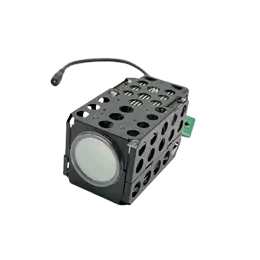SWIR (short wave infrared) is usually defined as light in the wavelength range of 900-1700nm, and can also be defined between wavelengths of 1000-2500nm, where water absorbs SWIR at 1400, 1900, and 2400nm. At its core, this SWIR definition means that imaging in this band is based on reflected light, similar to visible cameras, rather than on emitted thermal energy.
SWIR is invisible to the naked eye. The development and application of SWIR have improved due to the development of SWIR detectors. The indium gallium arsenide sensor is the main sensor used in SWIR imaging, covering the typical SWIR band, but can extend from 550nm to 2500nm. Detectors working in the SWIR band include mercury cadmium telluride detectors and indium antimonide detectors. Sensors made of mercury cadmium telluride and indium antimonide materials are very sensitive in the SWIR band. In order to increase their signal-to-noise ratio to a useful level, the camera using this type of detector must be mechanically cooled to an extremely low temperature. This working mode limits SWIR short wave infrared to application platforms such as large aircraft used for reconnaissance and surveillance that have a large space and power to load mechanical refrigeration systems. In contrast, InGaAs infrared focal plane detectors do not require refrigeration equipment. It can achieve almost the same sensitivity at normal temperatures, and you don't need to consider optical secondary imaging during the design.
Both mid-wave infrared and long-wave infrared are radiation emitted by the object itself, but SWIR is different. Although some SWIR is also the radiation emitted by the object itself, SWIR is similar to visible light, so SWIR is also the light reflected by the object itself. Since swir inspection is the radiation or reflected light emitted by the object itself, the SWIR optical system can passively acquire target information, and it has good concealment and safety.
Also due to this similarity, SWIR, and material effects are also similar, so SWIR images will have shadows and contrasts, making SWIR images have resolution and detail characteristics comparable to visible light images, but the image of SWIR is without color. For example, a thermal imager can only detect the presence of an object in a cold and hot background, a SWIR camera can identify what the object is, and a thermal imager cannot provide the resolution and dynamic range that a SWIR camera can achieve.
Both ambient starlight and background light at night can be used as natural illuminants of SWIR to provide illumination for night imaging. SWIR can be better used for night-light imaging. The swir technology is applied in an Infrared night vision camera. The swir image sensors can capture targets at night. Although water absorbs SWIR in three bands, you don't need to worry about the water in the soil, images will still appear at these wavelengths.



